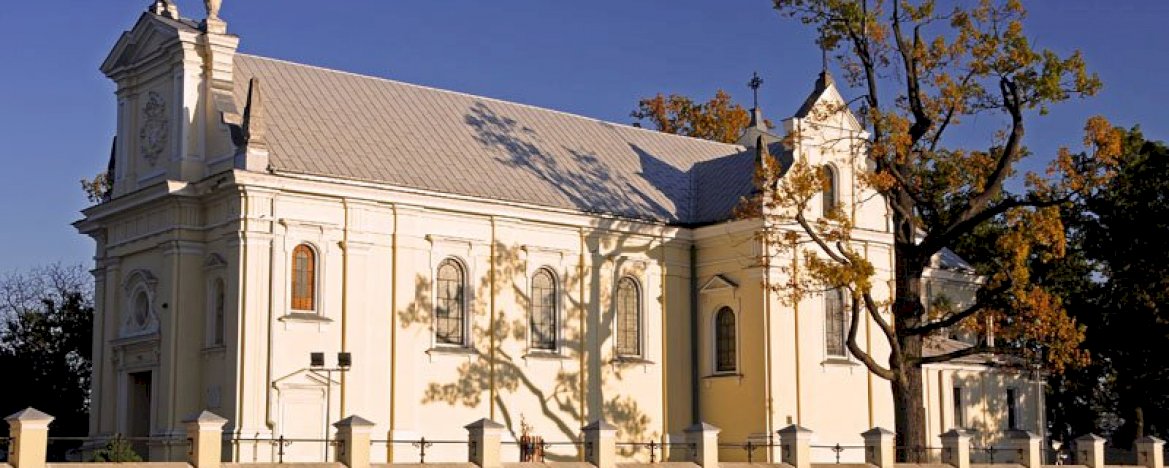
St. Anthony of Padua Parish Church in Wola Kiełpińska
The church in Wola Kiełpińska is one of
the most interesting examples of 19th century
sacral architecture in the Legionowo
County. The decision was taken after the
Russian government bought the Radziwill
property to build a fortress. The land for the
construction of the temple, together with the
land for the construction of the presbytery
and the cemetery, was donated to the parish
by the Radziwiłł family in autumn 1893.
A single-nave church was built in the years
1894-1899, according to the design
by Konstanty Wojciechowski (1841-1910).
Inside the church, epitaphs of the Krasinski family draw our attention. They were transferred from the church in Zegrze, including two Rococo epitaphs from the 18th century. The first one dedicated to Antoni Krasinski – the castellan of Zakroczym and founder of the church in Zegrze, who died in 1762. The second epitaph commemorates the second wife of Kazimierz – Eustachia née Potocka who died in 1764. The representatives of this family took part in both national uprisings and the Napoleonic Wars. The subsequent epitaphs of the Krasinski family date back to the 19th century, and include oboźny (senior official involved in setting up military camps) Kazimierz Krasinski – Knight of the Order of the White Eagle, the Speaker of the Sejm in 1782 who died in 1802, and his son – the castellan and the Senator Józef Wawrzyniec (1783-1945), who took part in the Napoleonic wars and in the November Uprising and was the commander of the 1st Warsaw Regiment for National Defence, and his grandson – Stanislaw (1811-1849), officer in the November Uprising decorated with the Golden Cross of the War Order of Virtuti Militari.
The temple was also the final resting place of its founder, Prince Maciej Radziwill (1842-1907), master of the hunt at the imperial court, former president of the Agricultural Society and of the Charitable Society in Warsaw. Up to 1966, the grave of the private Kozlowski, who died during the 1920 Polish-Soviet War, was situated in front of the church. In 1966, the tomb was transferred to the cemetery.
On the outer wall of the church, at the main entrance, there is a memorial plaque funded by the local population on the November 11, 1928, to commemorate the anniversary of Poland’s recovery of independence.
Inside the church, epitaphs of the Krasinski family draw our attention. They were transferred from the church in Zegrze, including two Rococo epitaphs from the 18th century. The first one dedicated to Antoni Krasinski – the castellan of Zakroczym and founder of the church in Zegrze, who died in 1762. The second epitaph commemorates the second wife of Kazimierz – Eustachia née Potocka who died in 1764. The representatives of this family took part in both national uprisings and the Napoleonic Wars. The subsequent epitaphs of the Krasinski family date back to the 19th century, and include oboźny (senior official involved in setting up military camps) Kazimierz Krasinski – Knight of the Order of the White Eagle, the Speaker of the Sejm in 1782 who died in 1802, and his son – the castellan and the Senator Józef Wawrzyniec (1783-1945), who took part in the Napoleonic wars and in the November Uprising and was the commander of the 1st Warsaw Regiment for National Defence, and his grandson – Stanislaw (1811-1849), officer in the November Uprising decorated with the Golden Cross of the War Order of Virtuti Militari.
The temple was also the final resting place of its founder, Prince Maciej Radziwill (1842-1907), master of the hunt at the imperial court, former president of the Agricultural Society and of the Charitable Society in Warsaw. Up to 1966, the grave of the private Kozlowski, who died during the 1920 Polish-Soviet War, was situated in front of the church. In 1966, the tomb was transferred to the cemetery.
On the outer wall of the church, at the main entrance, there is a memorial plaque funded by the local population on the November 11, 1928, to commemorate the anniversary of Poland’s recovery of independence.
